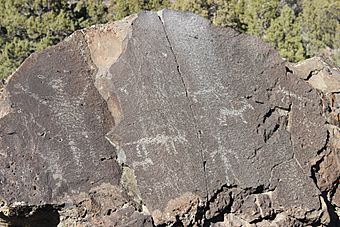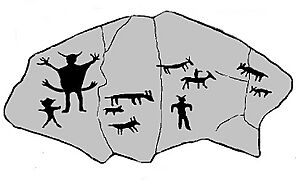Picture Rock Pass Petroglyphs Site facts for kids
Quick facts for kids |
|
|
Picture Rock Pass Petroglyphs Site
|
|

Petroglyphs near summit of Picture Rock Pass
|
|
| Location | Lake County, Oregon, USA |
|---|---|
| Built | Unknown |
| Architectural style | Prehistoric rock art |
| NRHP reference No. | 75001585 |
| Added to NRHP | 1975 |
The Picture Rock Pass Petroglyphs Site is a special place in northern Lake County, Oregon, United States. It's found near the top of Picture Rock Pass. The Bureau of Land Management takes care of this land. Ancient Native Americans carved these designs into a large basalt rock. They likely made them between 7,500 and 12,000 years ago. No one knows exactly what these carvings mean. This site is very important for history and culture. Because of this, the Picture Rock Pass Petroglyph Site was added to the National Register of Historic Places in 1975.
Contents
Ancient Oregon: A Land of Lakes
After the last Ice Age ended, huge glaciers melted. This meltwater filled up many basins in what is now south central Oregon. These areas became large pluvial lakes. For example, Summer Lake basin was south of Picture Rock Pass. The Silver Lake basin was north of the pass.
These lakes had many marshes and meadows around them. This was a perfect home for lots of wildlife. Animals like bison, deer, antelope, and mountain sheep lived here. Many kinds of waterfowl also thrived. All this wildlife attracted ancient hunters to the area.
Early People in the High Desert
We don't know exactly when the first people arrived in south central Oregon. But there is proof that Native Americans have lived here for over 12,000 years. We don't know much about these early people. We do know they camped and hunted near the old lakes around Picture Rock Pass.
Scientists found tools from the Clovis culture at Fort Rock Cave and Paisley Caves. These archeological sites are close to the pass. Fort Rock Cave is about 29 miles (47 km) north of the pass. The Paisley Caves are about 20 miles (32 km) south. They overlook Summer Lake. Besides leaving tools in caves, these early people also carved designs into rocks. They did this at many sites in south central Oregon, including Picture Rock Pass.
The Mysterious Rock Carvings
The Picture Rock Pass petroglyphs are carved on a large basalt rock. This rock faces south, near the top of the pass. No one knows for sure when these carvings were made or who made them. But they were likely created a very long time ago. This was either during the Clovis Period (10,000 to 12,000 years ago) or the Stemmed Point Period (7,500 to 10,000 years ago). So, the carvings are probably between 7,500 and 12,000 years old.
When the first European settlers came to southeastern Oregon in the 1840s, the Yahuskin Band of the Northern Paiute tribe lived in this area. Other tribes, like the Tenino people from Warm Springs and Klamath people from southern Oregon, might have also used areas around Picture Rock Pass. This is because Native Americans in this region often moved around. However, it's possible that none of these tribes made the carvings, given how old they are.
The meaning of the Picture Rock Pass petroglyphs is still a mystery. Some people think they were used in hunting ceremonies. Others believe they marked important travel routes for native peoples. The carvings might also have shown tribal land. Or they could have recorded myths or important events. It's also possible they were just fun designs made by an ancient artist. All these ideas are possible, but no one knows for sure why they were made.
There are ten figures in the Picture Rock Pass petroglyph group. Three of them look like humans. One is a small stick figure in the bottom left. Another human figure is in the middle-right along the bottom. The largest human-like figure is very interesting. It looks like a person but also has big horns. It might even have a second set of arms. This could mean it represents a spirit figure.
The other seven figures are four-legged animals. They might be animals hunted for food or hunting dogs. One animal in the center seems to have a rider. However, experts noticed that the rider's color and texture are different. This suggests the rider was added later, after the original carving. If that's true, the original animal might have been a mountain sheep or another game animal.
Protecting Ancient Art
Luckily, the Picture Rock Pass site has not been damaged by people. But the petroglyphs are very old and delicate. They need to be protected. Ancient petroglyph sites are very important for history. They are also often connected to Native American cultural practices. So, when these sites are found on United States Government lands, they are marked for protection.
Most government-owned petroglyph sites are called Areas of Critical Environmental Concern. This special name helps make sure these cultural treasures are kept safe. Because of its cultural importance and unique history, the Picture Rock Pass Petroglyphs Site was added to the National Register of Historic Places on August 28, 1975.
The Bureau of Land Management has carefully mapped and recorded the site. They take photos to see how the site changes over time. Volunteers from the Archaeological Society of Central Oregon also help. They work with Bureau of Land Management experts to watch over the site.
Finding the Petroglyphs
The Picture Rock Pass petroglyphs are on land owned by the Bureau of Land Management. They are just south of Oregon Route 31. This is between the small towns of Silver Lake and Summer Lake. The exact spot of the petroglyphs is not clearly marked. But the site is less than 100 feet (30 m) from the highway.
Images for kids







